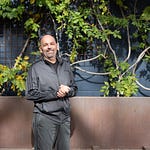Sana Sana says he's working to bridge the gap between dehumanization and injustices to land and water through hip hop, illustration, and direct action. “I was pretty much born an artist, but I feel like I didn’t really start coming into my own,” said Sana Sana, a local Reno visual and hip hop artist “until I dedicated my art to saying something that was meaningful to the people and for the land.” He does not believe art and activism are independent of one another. He goes by Sana, which is Spanish for heal as his chosen name because of the song mothers from his community sing to their kids when they get hurt, sana sana colita de rana. Originally from Milwaukee, Sana Sana came to Reno about fifteen years ago. His artwork is based in illustration, having worked as a tattoo artist for fifteen years. As the pandemic wore on, he chose to leave a local shop. It was an opportunity to break out on his own and focus more on his work and be selective about whom he tattoos. Sana Sana draws heavily on his ancestry for not just inspiration but also to live up to who he is. His family goes back to the people of central Mexico where he says poetry is the highest form of expression. “When something moves me to say something, that’s when I create,” he said “that can be either an illustration or it can be a song.” His mother’s side is Coahuilteca, an Indigenous group from southern Texas and his father’s side is Purépecha, a group of people living in Michoacán, located in central Mexico. Listen to the episode for more with reporter Richard Bednarski, including song clips.
1×
0:00
Current time: 0:00 / Total time: -21:41
-21:41
Sana Sana, an Artist Protecting Humans, Land and Water
Apr 29, 2021
Our Town Reno
With audio postcards from the streets, and inspiring interviews with community activists, we address issues of homelessness, the disappearance of public space, gentrification and the value of helping each other out from our base in Reno, Nevada. We do live reporting, micro storytelling and spoken word. As we face an affordable housing crisis, what happens to our most vulnerable?
With audio postcards from the streets, and inspiring interviews with community activists, we address issues of homelessness, the disappearance of public space, gentrification and the value of helping each other out from our base in Reno, Nevada. We do live reporting, micro storytelling and spoken word. As we face an affordable housing crisis, what happens to our most vulnerable?Listen on
Substack App
RSS Feed
Recent Episodes














Share this post